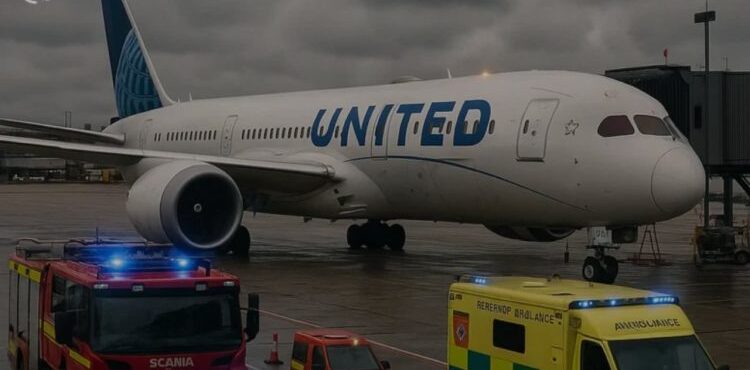Introduction: Brief overview of United Airlines Flight UA770 emergency diversion
On a seemingly routine day in the skies, United Airlines Flight UA770 found itself at the center of an unexpected turn of events. What should have been a smooth journey quickly transformed into an emergency diversion that left passengers and crew on high alert. As travelers rely on airlines to keep them safe while soaring thousands of feet above ground, incidents like this serve as critical reminders about the unpredictability of air travel. Let’s delve into what unfolded during this flight, explore the underlying causes behind its sudden change in course, and discover invaluable safety lessons we can all learn from such experiences.
What happened during the flight?
During United Airlines Flight UA770, an unexpected emergency unfolded mid-flight. As the aircraft soared over a remote region, passengers noticed unusual vibrations and sounds.
The flight crew quickly assessed the situation, realizing something was amiss with one of the engines. The captain initiated immediate protocols to ensure passenger safety.
Within moments, communication with air traffic control became crucial. The decision was made to divert toward a nearby airport for precautionary landing.
Passengers felt a mix of anxiety and relief as they were informed about the diversion. Crew members worked diligently to keep calm in what could have been a chaotic atmosphere.
As they descended towards their new destination, passengers braced themselves but remained hopeful for a safe resolution.
Causes of the emergency diversion
The emergency diversion of United Airlines Flight UA770 was triggered by a combination of factors.
Initially, reports indicated that there were mechanical issues with the aircraft. A malfunctioning sensor alerted the crew to potential problems, prompting them to assess their options quickly.
Weather conditions also played a role in the decision-making process. Turbulence and unexpected storms along the planned route added urgency to an already complex situation.
Communication between pilots and air traffic control became crucial at this juncture. Updates about changing conditions allowed for informed decisions regarding safe landing sites.
Crew training proved invaluable as they navigated these challenges, ensuring passenger safety remained paramount throughout the ordeal. As tensions rose, maintaining composure and professionalism was key for all involved.
Safety precautions and procedures during an emergency diversion
During an emergency diversion, flight crews follow strict protocols to ensure the safety of all onboard. Communication is key. The captain updates passengers about the situation as quickly and clearly as possible.
Cabin crew members prepare for landing by securing loose items and ensuring that everyone is seated with their seatbelts fastened. This helps protect passengers from potential turbulence or sudden movements.
In addition, evacuation procedures are rehearsed regularly. Crew members know how to guide passengers safely to exits if needed. They practice using emergency slides and directing people away from the aircraft.
Passengers are also educated through safety briefings provided before takeoff. Familiarity with these instructions can make a difference in stressful situations.
Staying calm during an emergency is crucial for both crews and travelers alike. Proper training enables teams to act swiftly while keeping passenger welfare at the forefront of their actions.
Impact on passengers and crew
The impact on passengers during the United Airlines Flight UA770 emergency diversion was significant. Many experienced heightened anxiety and fear, as unexpected situations can be incredibly stressful. The uncertainty of the situation likely intensified these feelings.
Crew members had to remain calm and composed, guiding passengers through this unsettling event. Their training kicked in as they communicated clearly about what was happening and what steps were being taken.
After landing safely, there was a mix of relief and exhaustion among everyone aboard. Passengers shared their experiences, bonding over a moment that could have turned tragic but instead highlighted the importance of teamwork.
Support services were made available upon arrival to assist those who needed it. This incident served as a reminder of how crucial it is for both crew and passengers to stay focused during emergencies while relying on one another for support.
Lessons learned from this incident
The United Airlines Flight UA770 emergency diversion serves as a crucial case study in aviation safety. It highlights the importance of preparedness among crew members.
Training plays a vital role in how quickly and effectively flight attendants can react to unexpected situations. Regular drills ensure that responses are instinctive, not reactionary.
Communication is another key takeaway. Clear dialogue between pilots and cabin crew can streamline decision-making during emergencies, minimizing panic and confusion.
Passengers also have a part to play; understanding safety protocols empowers them to remain calm when faced with sudden changes.
This incident underscores the significance of continuous improvement in safety measures within the airline industry. Evaluating past incidents helps shape future protocols, fostering safer skies for everyone involved.
Conclusion: Importance of following safety protocols in air travel
The events surrounding the United Airlines Flight UA770 emergency diversion highlight a crucial aspect of air travel: safety protocols are not just guidelines; they are essential measures that protect lives. Following established procedures during emergencies is vital for ensuring passenger and crew safety.
Incidents like these remind us why rigorous training and adherence to safety regulations matter. They provide significant learning opportunities for airlines, regulatory bodies, and passengers alike. By understanding the importance of these protocols, we can all contribute to creating a safer flying experience.
Staying informed about airline safety practices empowers travelers to make better decisions while fostering confidence in their journeys. Therefore, whether you’re taking a short trip or an international flight, always respect the rules set forth by aviation authorities—and remember that your safety is everyone’s priority in the skies.

















